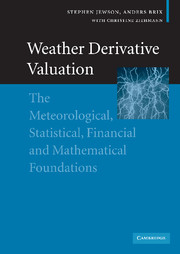 Weather Derivative Valuation
Weather Derivative Valuation Book contents
- Frontmatter
- Contents
- List of figures
- List of tables
- Acknowledgements
- 1 Weather derivatives and the weather derivatives market
- 2 Data cleaning and trends
- 3 The valuation of single contracts using burn analysis
- 4 The valuation of single contracts using index modelling
- 5 Further topics in the valuation of single contracts
- 6 The valuation of single contracts using daily modelling
- 7 Modelling portfolios
- 8 Managing portfolios
- 9 An introduction to meteorological forecasts
- 10 The use of meteorological forecasts in pricing
- 11 Arbitrage pricing models
- 12 Risk management
- 13 Modelling non-temperature data
- A Trend models
- B Parameter estimation
- C Goodness of fit tests
- D Expected pay-offs for normally distributed indices
- E Pay-off variances for normally distributed indices
- F Greeks for normally distributed indices
- G Exact solutions for the kernel density
- H The beta for a normally distributed index
- I Simulation methods
- J Efficient methods for pricing against a portfolio
- References
- Index
2 - Data cleaning and trends
Published online by Cambridge University Press: 22 September 2009
- Frontmatter
- Contents
- List of figures
- List of tables
- Acknowledgements
- 1 Weather derivatives and the weather derivatives market
- 2 Data cleaning and trends
- 3 The valuation of single contracts using burn analysis
- 4 The valuation of single contracts using index modelling
- 5 Further topics in the valuation of single contracts
- 6 The valuation of single contracts using daily modelling
- 7 Modelling portfolios
- 8 Managing portfolios
- 9 An introduction to meteorological forecasts
- 10 The use of meteorological forecasts in pricing
- 11 Arbitrage pricing models
- 12 Risk management
- 13 Modelling non-temperature data
- A Trend models
- B Parameter estimation
- C Goodness of fit tests
- D Expected pay-offs for normally distributed indices
- E Pay-off variances for normally distributed indices
- F Greeks for normally distributed indices
- G Exact solutions for the kernel density
- H The beta for a normally distributed index
- I Simulation methods
- J Efficient methods for pricing against a portfolio
- References
- Index
Summary
Actuarial pricing methods for weather derivatives depend on statistical modelling of stationary time series of historical meteorological data. This is described in chapters 3 to 6 for single contracts, and chapters 7 and 8 for portfolios. However, historical meteorological data is anything but stationary, and we must process it in a number of ways before the pricing methods can be applied. Firstly, we must clean the data to remove absurd values and fill gaps. Secondly, we must identify (and perhaps attempt to remove) jumps in the data that occur as a result of station changes. Finally, we may need to remove gradual trends from the data. Our discussion of the methods used for identifying and replacing absurd values, filling gaps and identifying and removing jumps will be rather cursory; a more thorough explanation is given in Boissonnade et al., 2002. We will, however, discuss the identification and removal of trends in some detail.
Data cleaning
Meteorological data measurements are usually made by national meteorological services (NMSs), and occasionally by universities, private companies or military organisations. We will restrict ourselves to a discussion of the data measured by the NMSs since this is what is generally used in the weather market. In many parts of the world measurements exist that go back at least fifty years, and in some cases much longer. However, as we shall discuss below, even very recent data already has significant problems with reliability and homogeneity, and earlier data is usually significantly worse.
- Type
- Chapter
- Information
- Weather Derivative ValuationThe Meteorological, Statistical, Financial and Mathematical Foundations, pp. 37 - 58Publisher: Cambridge University PressPrint publication year: 2005


